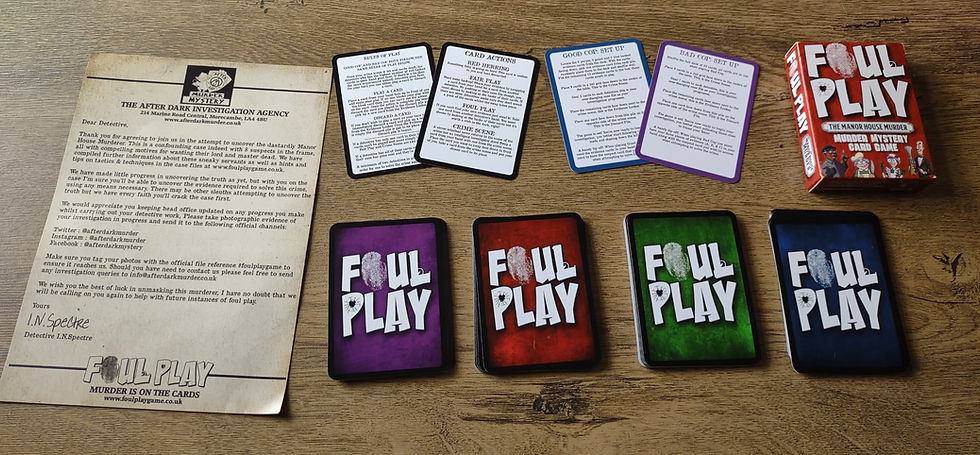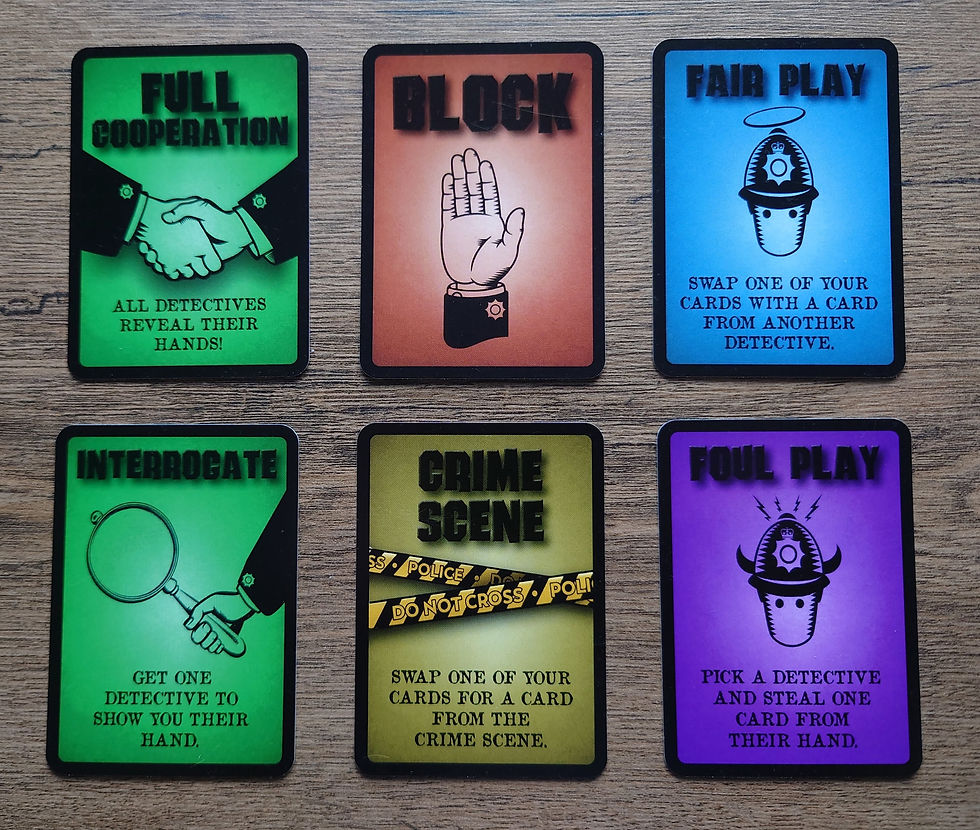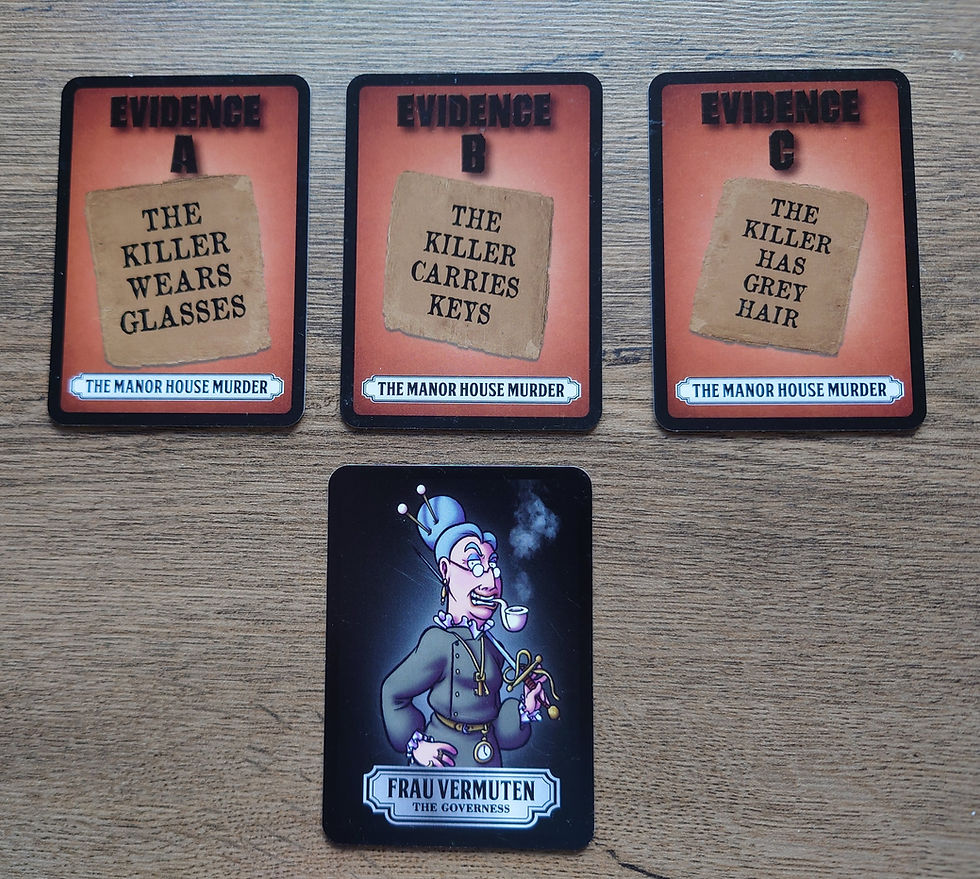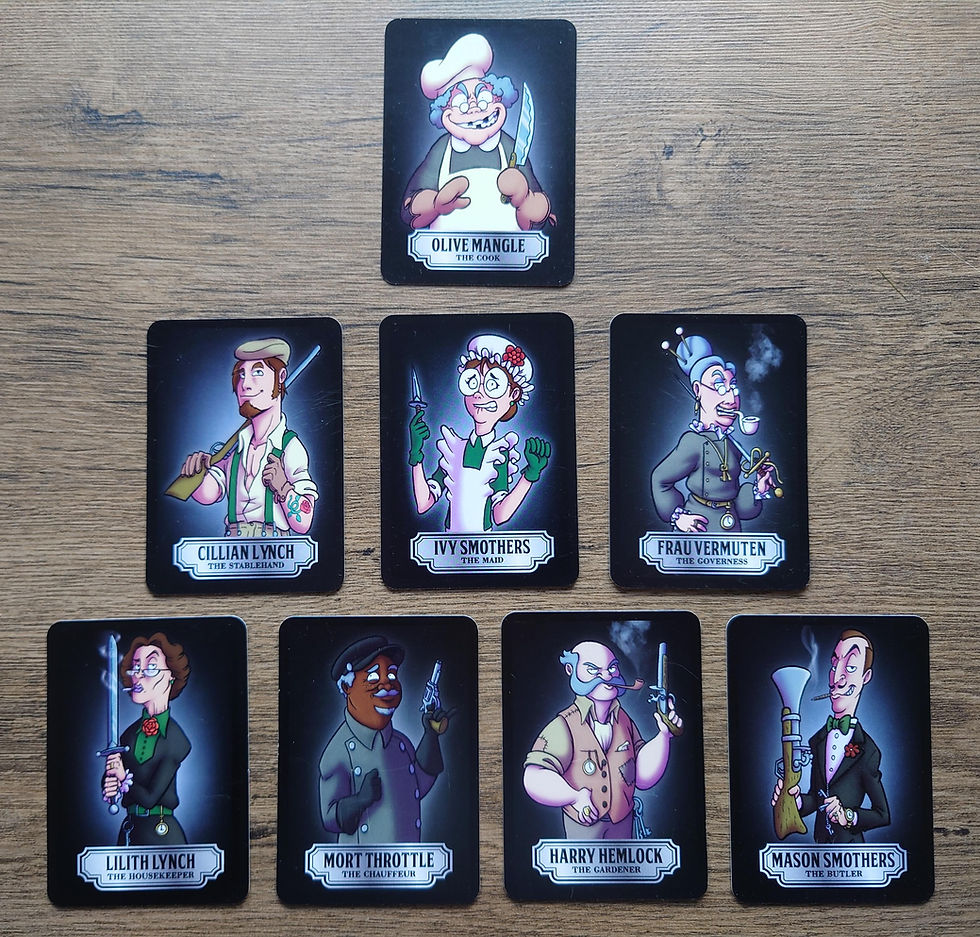Foul Play - a murder most foul!
- Rebeka Lewis

- Mar 5, 2021
- 6 min read
Updated: Jan 14, 2024
Players: 2-5 Ages: 14+ Game Time: 10-20mins (2 players)
I love murder mysteries. From the full-on dress-up party experiences, through to a “quick” family game of Cluedo, it is always a genre I’m excited to play. Having never played an entirely card-based murder mystery (which will hereon be referred to as MM so that the words “murder mystery” don’t start looking weird), I was curious to try out Foul Play - a new MM card game by After Dark Murder Mystery.

In Foul Play you take the role of a detective, and your aim is to use the pieces of evidence within the deck to identify the perpetrator of the Manor House Murder. The game is competitive, so your goal as the player is not only to come to the correct conclusion, but to do so before the other players. Be careful though, because if your case goes cold (if you run out of cards in your hand) it’s game over, which is an outcome I skated close to a few times, but managed to narrowly avoid. The process of discovery and accusation does vary slightly depending on whether you’re playing “Good Cop” or “Bad Cop” rules, but they’re broadly similar in that you need to see three pieces of evidence and to locate a suspect that matches the description.
In the “Good Cop” mode, three pieces of evidence equating to one suspect description are shuffled into the deck and each player competes to discover and piece together the three clues so they can finger the correct suspect. In order to make an accusation, the player must locate the correct suspect card and manage to get it into their hand - a feat which is easier said than done. I had a rather frustrating experience on my first attempt at “Good Cop”, where I had seen all three clues by the midway point and knew that my opponent had the suspect I needed in his hand, but luck was not on my side and I never did manage to take that card.
My favourite of the two game modes is “Bad Cop”, where rather than using established evidence to identify a suspect, you build your own case based on the cards you have available in-hand. The flavour text on the “Bad Cop” rules card implies that this is a sort of performative justice and you don’t care whether the accused is truly responsible, as long as you “solve” the case. In this mode there are 12 pieces of evidence in the deck, and the player’s job is to collect one piece of evidence from each of the three evidence categories and a suspect card that fits the description. This game mode feels a bit more balanced to me, primarily because you’re less likely to be completely reliant upon one specific card.

Gameplay
In terms of the gameplay itself, it’s very simple to learn and most of the crucial pieces of information are on the cards, which I like. Each player has a starting hand, whose number varies depending on game mode, and there’s also a 3x3 grid of face-down cards in the centre of the table known as the “crime scene”. There’s nothing special about these cards, but it does offer an extra mechanic which potentially slows down an investigation. A basic turn involves playing (or discarding) a card and drawing a new one.
There are three types of cards in the deck: action, evidence, and suspect; but the only ones you can “play” are the action cards. A common action card may allow you to swap a card from your hand into a player’s hand or steal a card from a player. Rarely, you may find an action card that will force an opponent to show you their hand, or for all players to reveal their hands to each other. There are a number of “crime scene” action cards which allow you to exchange a card from your hand with a mystery card from the crime scene. Two “block” action cards exist within the deck, which can be played at any time to prevent one opponent from continuing with their turn, even during a crime-solving attempt. These don’t work particularly well in two-player games, but I can see them being effective with a larger player count.

Evidence cards are divided into three sub-types: A, B, and C. There is no functional difference between these sub-types, but both game modes require you to use a piece of evidence from each category in your conclusion. This categorisation of evidence ensures that each set of three clues always applies to one of the suspect cards, which I am consistently impressed by. Each evidence has a short statement on it describing a suspect as depicted on the suspect cards, for example “the killer wears glasses'', to help you pinpoint the perp.

There are eight suspect cards, each showing a character’s image, as well as their name and occupation. The art on these cards is bright and compelling, and I love the cartoon style. In games dealing with potentially serious subject matter like this, the art often sets the tone between silly and serious - Foul Play lies clearly on the silly side of the fence. Each character is fairly distinct and oozing with personality. I do have a fairly active imagination but I find it quite easy to visualise their personalities and voices, which is ultimately a product of great design. I particularly like Olive Mangle, who I imagine as being a post-Chicken Run Mrs. Tweedy.


Production
The overall component quality is good, though a few of my cards had scratches right out of the plastic wrap. The cards are quite lightweight and flexible making them great for riffling, if you’re that way inclined. Quite a few of the action cards have dark shadowed text on a dark background which isn’t very easy to read, but if you have good colour vision you’ll start to recognise the cards by colour rather than text after a few rounds.
Conclusion
The balancing of evidence to suspects is quite cleverly implemented, but there are minor issues throughout. The different types of actions are quite limited in number and you can be left, as I was, playing a very long waiting game to secure the final card you need when it’s in the hand of another player. In a two-player game, it’s extremely difficult to stop your opponent from winning and requires a good amount of luck with your draws and hand management. “Bad Cop” mode can theoretically be won instantly depending on the shuffle and deal, which fortunately wasn’t my experience but isn’t at all outside the realms of possibility.
We also found that the crime scene was scarcely used in our games as it’s easier to burn through the deck to locate cards you need - this is especially true of “Bad Cop” mode where you can be a bit more flexible with your case. We equally noted that the crime scene itself could contain all of the crime scene action cards, rendering it unusable, which doesn’t seem totally improbable given that in a “Good Cop” setup nearly 14% of the cards are crime scene actions.
For me, the major thing that’s missing from Foul Play is a story. There are some brief character descriptions available on the website including basic motives, but as a guest player I think I’d be unlikely to whip out my phone at the table to read them. There isn’t much narrative on offer in the box, aside from two sentences to tell you that the Lord is dead and one of the servants did it. When I am indulging in a MM, the main thing that entertains me are the details and how they fit together, and I would love to see more of this from After Dark’s debut card game given how excellent the reviews of their live events are.

I’m not quite sure who the target audience is for this game. If you like a MM, this game is missing key aspects that hook you in, especially a meaningful story. This game might be okay as a quick game to open a games night with four or five players, but there are plenty of other short party games out there which have much more varied and interesting gameplay than Foul Play. If you do want to give it a go, you can pick it up for the very reasonable price of £8.95 from foulplaygame.co.uk.
Rebeka












Comments